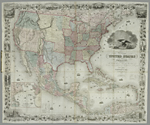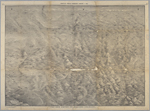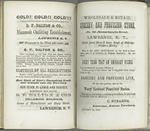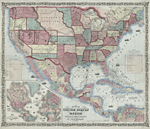Mining the West
"We had not less than thirty thousand 'feet' apiece in the 'richest mines on earth.' … We were stark mad with excitement -- drunk with happiness -- smothered under mountains of prospective wealth -- arrogantly compassionate toward the plodding millions who knew not our marvelous canyon -- but our credit was not good at the grocer's." — Mark Twain, Roughing It (1872)
The stunning discovery of gold at Sutter's fort in California in
January 1848 had a major impact on mapping after that date; many
maps should be viewed in the context of "before
1848" and "after 1848." Even world maps made room
for gold-painted patches on California to make clear where the
goods were. Gold created a fever, which spurred the building of
roads and railroads to speed the travel west. Earlier, the impetus
had been British and Russian incursions on the Pacific coast; now
gold fever instantly changed motivations and emigration patterns.
California became an important destination, and San Francisco's
population boomed. World maps emphasized railroad routes west and
shipping routes across the Central American isthmus. Guidebooks
for travelers across land and sea were instant bestsellers.
Popular writers from Mark Twain to the explorer John Charles
Frémont wrote about the gold fields.
But California was not alone in its golden treasure. Colorado,
Wyoming, Alaska, and Idaho all were known for periods of time for
their gold mines and potential for making anyone rich. The
mapmakers were not subtle as they created and sold thousands of
maps pointing the way to worldly wealth.
Gold fever also led to continuing conflicts with Native
Americans. General George Armstrong Custer, a hero in the Civil
War, led an expedition in 1874 to the Black Hills, where his
troops discovered gold. When word got out, Americans seeking gold
poured into areas considered sacred by Native Americans,
thereby violating treaties signed by the U.S. government.
Native Americans fought for their land, which led to the battle of
the Little Bighorn (1876), a direct result of gold fever.
The maps in this section are products of the widespread dreams for
material goods and wealth initially spurred by the gold rush of
'48-'49 and later discoveries of gold and silver.
 1
1
|
|
|
G. Woolworth Colton Map of the United States of America…, 1849 NYPL, Map Division |
|
 2
2
|
|
|
The New Empire of Western Colorado, 1888 NYPL, Map Division |
|
 3
3
|
|
|
William B. Parsons The New Gold Mines of Western Kansas and Nebraska…, 1859 NYPL, Map Division |
|
|
|
|
|
